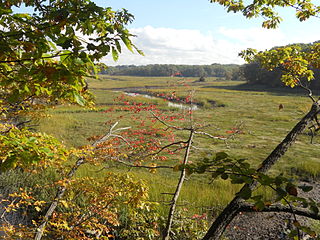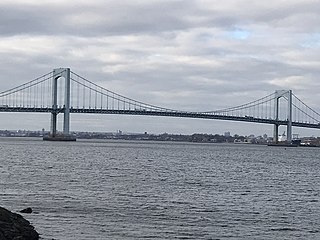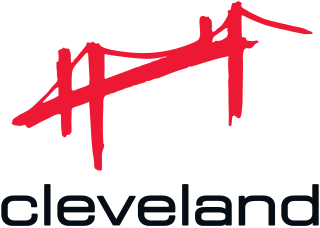Related Research Articles

Othmar Hermann Ammann was a Swiss-American civil engineer whose bridge designs include the George Washington Bridge, Verrazzano-Narrows Bridge, and Bayonne Bridge. He also directed the planning and construction of the Lincoln Tunnel.

Old Bridge Township is a township in Middlesex County, in the U.S. state of New Jersey, located in the Raritan Valley region and within the New York metropolitan area. As of the 2020 United States census, the township was the state's 21st-most-populous municipality, with a population of 66,876, an increase of 1,501 (+2.3%) from the 2010 census count of 65,375, which in turn reflected an increase of 4,919 (+8.1%) from the 60,456 counted at the 2000 census. As of the 2010 Census, the township was ranked 18th in the state by population, after being the state's 21st most-populous municipality in 2000. Old Bridge is a bedroom suburb of New York City located across the Raritan Bay from Staten Island, and it is about 25 miles (40 km) from Manhattan, and about 30 miles (48 km) south of Newark.

Aberdeen Township is a township situated on the Jersey Shore in Monmouth County, in the U.S. state of New Jersey. The township is located within the Raritan Valley region and is a part of the New York Metropolitan Area, bordering both Old Bridge Township, New Jersey in adjacent Middlesex County, New Jersey, as well as Staten Island in New York City. As of the 2020 United States census, the township's population was 19,329, its highest decennial count ever and an increase of 1,119 (+6.1%) from the 2010 census count of 18,210, which had in turn reflected an increase of 756 (+4.3%) from the 17,454 recorded at the 2000 census.

Matawan is a borough in Monmouth County, in the U.S. state of New Jersey. A historic community located near the Raritan Bay in the much larger Raritan Valley region, the borough is a commuter town of New York City within the New York Metropolitan Area. As of the 2020 United States census, the borough's population was 9,565, an increase of 755 (+8.6%) from the 2010 census count of 8,810, which in turn reflected a decline of 100 (−1.1%) from the 8,910 counted in the 2000 Census.

The Throgs Neck Bridge is a suspension bridge in New York City, carrying six lanes of Interstate 295 (I-295) over the East River where it meets the Long Island Sound. The bridge connects the Throggs Neck section of the Bronx with the Bay Terrace section of Queens.

The Garabit viaduct is a railway arch bridge spanning the Truyère, near Ruynes-en-Margeride, Cantal, France, in the mountainous Massif Central region.

Interstate 295 (I-295) is an auxiliary Interstate Highway within New York City. Measuring 7.7 miles (12.4 km) in length, I-295 originates at Hillside Avenue in Queens, running north across Queens and over the tolled Throgs Neck Bridge, to Bruckner Interchange, a junction with I-95, I-278, I-678, and the Hutchinson River Parkway in the Bronx. From south to north, I-295 intersects the Grand Central Parkway, I-495, and the Cross Island Parkway in Queens before crossing the Throgs Neck Bridge and splitting with I-695. In Queens, I-295 is also known as the Clearview Expressway.

Hardinge Bridge is a steel railway truss bridge over the Padma River located at Ishwardi, Pabna and Bheramara, and Kushtia in Bangladesh. It is named after Lord Hardinge, who was the Viceroy of India from 1910 to 1916. The bridge is 1.8 km (1.1 mi) long.

Matawan Creek is a creek and partially a tidal inlet of Raritan Bay. It lies in Monmouth County, New Jersey, United States, across from Staten Island, New York City.

The Pearl Harbor Memorial Bridge, commonly referred to as the Q Bridge by locals, is an extradosed bridge that carries Interstate 95 over the mouth of the Quinnipiac River in New Haven, in the U.S. state of Connecticut. This bridge replaced the original 1,300 m (0.8 mi) span which opened on January 2, 1958. The old bridge had a girder and floorbeam design where steel beams supported a concrete bridge deck that carried three lanes of traffic in each direction with no inside or outside shoulders. The bridge was officially dedicated as the Pearl Harbor Memorial Bridge in 1995 to commemorate the attack on Pearl Harbor.

Cleveland Bridge & Engineering Company was a UK bridge works and structural steel contractor based in Darlington. It built landmarks including the Victoria Falls Bridge in Zimbabwe; the Tees Transporter Bridge; the Forth Road and Humber suspension bridges in the UK; Hong Kong's Tsing Ma Bridge, and London's Wembley Stadium Arch.

The Pont de la Concorde is an arch bridge across the Seine in Paris connecting the Quai des Tuileries at the Place de la Concorde and the Quai d'Orsay. It has formerly been known as the "Pont Louis XVI", "Pont de la Révolution", "Pont de la Concorde", "Pont Louis XVI" again during the Bourbon Restoration (1814); in 1830, its name was changed again to Pont de la Concorde, the name it has retained to this day. It is served by the Metro stations Assemblée nationale and Concorde.

Fomento de Construcciones y Contratas, S.A., or FCC, is a Spanish construction company based in Barcelona. Until November 2014, over 50 percent of the shares were owned by a company controlled by the daughter of its founder, Esther Koplowitz and others, when George Soros bought around 25 percent of her rights to acquire shares.

The Banpo Bridge is a major bridge in downtown Seoul over the Han River, South Korea, connecting the Seocho and Yongsan districts. The bridge is on top of Jamsu Bridge, forming the upper half of a double-deck bridge; it is the first double deck bridge built in South Korea. During periods of high rainfall, the Jamsu Bridge is designed to submerge as the water level of the river rises, as the lower deck lies close to the waterline. In the past decade, the bridge has submerged every year, and the bridge and surrounding area is cleared of mud and silt shortly afterward. The bridge was built as a girder bridge and was completed in 1982.
The Wrought Iron Bridge Company was a bridge fabrication and construction company based in Canton, Ohio, United States. It specialized in the fabrication of iron truss bridges and was a prolific bridge builder in the late 19th century. It was one of the 28 firms consolidated by J. P. Morgan into the American Bridge Company in 1900. Many of its bridges have been listed on the National Register of Historic Places.

The Walt Whitman Bridge is a single-level suspension bridge spanning the Delaware River from Philadelphia in the west to Gloucester City in Camden County, New Jersey in the east. The bridge is named after American poet and essayist Walt Whitman, who resided in nearby Camden toward the end of his life.
Greenville Yard is a freight rail yard in the Port of New York and New Jersey. It is located on Upper New York Bay in Jersey City, New Jersey adjacent and north of Port Jersey. Originally developed in 1904 by the Pennsylvania Railroad, it was later taken over by Conrail. It has been owned by the Port Authority of New York and New Jersey since 2010. It takes its name from the former municipality of Greenville, now part of the city.

James Rich Steers was an American yacht builder and politician. He founded the George Steers and Co shipyard with his brother, George Steers.

The Rosendale Trestle is a 940-foot (290-meter) continuous truss bridge and former railroad trestle in Rosendale Village, a hamlet in the town of Rosendale in Ulster County, New York. Originally constructed by the Wallkill Valley Railroad to continue its rail line from New Paltz to Kingston, the bridge rises 150 ft (46 m) above Rondout Creek, spanning both Route 213 and the former Delaware and Hudson Canal. Construction on the trestle began in late 1870, and continued until early 1872. When it opened to rail traffic on April 6, 1872, the Rosendale trestle was the highest span bridge in the United States.
Leopold Just was a Latvian-born engineer who came to New York City in 1921, and eventually became a partner in the Ammann & Whitney firm of consulting engineers. He was involved in the design of many major New York City bridges, including parts of the George Washington Bridge and the Lincoln Tunnel, the Throgs Neck Bridge linking the Bronx and Queens and, most notably, the Verrazano-Narrows Bridge linking Staten Island with Brooklyn. His work outside of New York City included the Washington Metro, Ohio Turnpike and Connecticut Turnpike. He earned a degree in civil engineering from the Polytechnic Institute of Brooklyn in 1929, and died at age 95.
References
- ↑ Leagle: DeLong Corporation v. Lucas, 1959 "J. Rich Steers, Inc. were also well known contracting engineers"
- ↑ Air Force Report on the Loss of Texas Tower #4, 03/04/1961 "J. Rich Steers was a firm of long-standing experience having been in business in and around New York City for over 60 years specializing in waterfront construction"
- ↑ "J. Rich Steers - Chronology". Structurae Version 6.5 - © 1998-2014 Wilhelm Ernst & Sohn Verlag. Retrieved August 26, 2014.
- ↑ "Obituary: J. Rich Steers '85". Alumni Horae, Volume 16, Issue 1, Page 36. Spring 1936. Retrieved August 26, 2014.[ permanent dead link ]
- ↑ "Obituary: Henry Steers, '83". Alumni Horae, Volume 8, Issue 3, Page 97. 1928. Retrieved August 26, 2014.[ permanent dead link ]
- ↑ "Obituary: Henry Coster Steers, 1910". Alumni Horae, Volume 27, Issue 3, Page 109. Autumn 1947. Archived from the original on August 28, 2014. Retrieved August 26, 2014.
- ↑ Bill Bleyer (February 18, 1998). "Northport:A Harbor of Transformation". Newsday. Retrieved August 26, 2014.
- ↑ "Rail Service is Disrupted by Fire: Matawan Trestle Blaze Razes Crossing Over Creek, Meadows; Rush Repair Project" (PDF). The Matawan Herald. December 12, 1946. Archived from the original (PDF) on September 21, 2015. Retrieved August 26, 2014.
- ↑ "History: Matawan Creek Trestle Fire (1946)". Aberdeen NJ Life. January 9, 2012. Retrieved August 26, 2014.
- ↑ Newark Advocate article, 08/10/1917 "General Strike May Stop Work on Army Camps"
- ↑ St. Petersburg Independent article, 08/10/1917 "Settle Strike By Agreement"
- ↑ "US Navy Shipbuilding Contracts in the Navy Department Library (January 1941 to December 1945)". Naval History & Heritage Command. Retrieved August 26, 2014.
- ↑ Executive Order 9693: Possession Control and Operation of the Transportation Systems Plants and Facilities of Certain Towing and Transportation Companies Operating in New York Harbor and Contiguous Waters. U.S. Government Printing Office, The Code of Federal Regulations of the United States of America. 1957. Retrieved August 26, 2014.
- ↑ "Top 400 Construction Companies" (PDF). ENR. Retrieved August 26, 2014.
- ↑ "SEWAREN GENERATING STATION". PSE&G. 1949. Retrieved August 26, 2014.
- ↑ "Throgs Neck Bridge - Contractor". Structurae Version 6.5 - © 1998-2014 Wilhelm Ernst & Sohn Verlag. Retrieved August 26, 2014.
- ↑ "Commodore Barry Bridge - Contractor". Structurae Version 6.5 - © 1998-2014 Wilhelm Ernst & Sohn Verlag. Retrieved August 26, 2014.
- ↑ "J. Rich Steers - Chronology". Structurae Version 6.5 - © 1998-2014 Wilhelm Ernst & Sohn Verlag. Retrieved August 26, 2014.